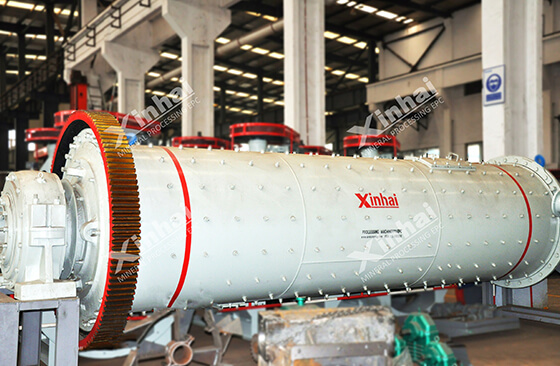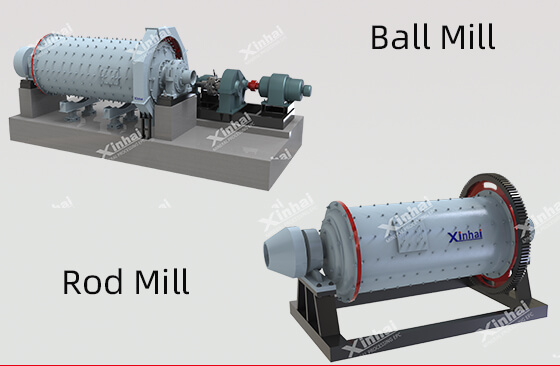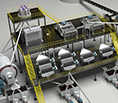Everything You Need to Know about Mineral Grinding Equipment
 Shirley
Shirley
 Jul 14, 2022
Jul 14, 2022
 2241
2241
If you want to know more details about equipment, solutions, etc, please click the button below for free consultation, or leave your requirements!

(Ball mill for mineral grinding)
Grinding equipment is one of the important machines used before mineral processing operation. The particle size of the ore is reduced by the impact and grinding of steel balls, steel bars, gravel and other media.
The quality of grinding products will directly affect the level of the separation index. Grinding equipment is also a part of the concentrating plant with higher costs and more investment. Therefore, in selecting grinding equipment, it is necessary to comprehensively consider various factors such as design, investment and environment before determining.
01 Grinding Equipment Working Principle
BackTaking a ball mill as an example, during grinding, the grinding medium and minerals in the cylinder rotate with the cylinder. When reaching the critical height, they fall off the cylinder and crush the ore. The grinding media grinds each other during the rotation. Minerals are crushed under the combined action of impact force and abrasive force.
The movement state of the grinding medium in the cylinder has a great influence on the grinding effect. Each combination has its appropriate critical speed, which is affected by both the filling rate and the rotating speed of steel balls. Because steel balls are consumables that need to be replaced regularly. Therefore, when replacing the steel ball, it needs to be filled according to its own filling rate, and it cannot be blindly filled.
02 Grinding Equipment Types
BackThere are many types of grinding equipment. According to the classification of grinding media, grinding equipment can be divided into ball mill, rod mill, gravel mill, self-grinding machine, semi-auto-grinding machine, etc. Grinding equipment commonly used in industrial production includes ball mills, rod mills, gravel mills, self-grinding mills and Ultra-fine pulverizers, etc.
According to different types of discharge, the ball mill can be divided into grid type ball mill and overflow type ball mill.
According to the water content of the medium, it can be divided into dry ball mill and wet ball mill. The classification of rod mill is similar to that of ball mill.
Ultra-fine pulverizer can be divided into Raymond mill, jet mill, vibrating mill, stirring mill and so on.
03 Ball Mill
BackWhen the ball mill operates, the grinding balls and material in the ball mill bin will produce Centrifugal force and friction force. The feeding material can be ground into fine powder under such force.
Ball mills can be widely used in ferrous metal beneficiation, non-ferrous metal beneficiation and non-metal beneficiation. According to different methods of mill discharge, they can be divided into grid type and overflow type. The Common grinding media include stainless steel balls and forged steel balls.
(1) Grid Ball Mill
The grid ball mill design consists of a feeding part, discharging part, rotary part, transmission part and other major parts. We install the discharging grid plate at the discharging end. Due to the continuously feeding materials, the pressure pushes slurry to the discharging grid and the ground materials are discharged from the discharging grid plate. The inside of the cylinder is lined with a wear-resistant liner to increase the wear resistance of the ball mill.
The size of the discharge of the grid-type ball mill is generally 0.2~0.3mm, which is often used in the one stage of grinding in the mineral processing plant.
(2) Overflow Ball Mill
The structure of the overflow ball mill is similar to the grid ball mill. But there are differences between overflow ball mill and grid ball mill. The slurry of overflow ball mill without grid plate overflows by itself. The discharge particle size of the overflow ball mill is generally less than 0.2mm, which is usually used for the second stage of grinding in mineral processing.

(Grid ball mill in gold processing plant)
04 Rod Mill
BackRod mill is a common equipment for grinding operation in the mineral processing plant, which is mainly suitable for rough grinding operation. The structure of a rod mill and ball mill is similar. The grinding medium in the barrel of the rod mill is steel rods, whose length is not more than 7mm and whose diameter is between 75 and 150mm.
The common types of rod mill are the wet overflow type rod mill, end edge discharge rod mill and center-periphery row ore rod mill so on.

(Rod mill for mineral grinding)
05 Autogenous Mill
BackAutogenous mill is grinding equipment that uses ores itself as grinding media. It can be divided into the dry autogenous mill and the wet autogenous mill. The common one in beneficiation plant is wet autogenous mill.
The advantage of the autogenous mill is that the raw ore or coarse crushing ores can be fed into an autogenous mill directly. It can realize crushing and grinding at the same time.
The barrel of the autogenous mill is short, and the diameter of the autogenous mill is as three times long as the length. The ores in the autogenous mill are by the falling impact force, the Instantaneous stress, and the friction force from gangues each other.

(Autogenous mill for mineral grinding)
06 Raymond mill
BackThe roller is tightly rolled on the ring under the action of centrifugal force. The material is broken into powder under the action of grinding pressure, and the powder material is blown to the analytical machine under the action of the fan. Materials that meet the fineness requirements will be returned to the grinding cavity to continue grinding through the analytical machine if they fail to meet the requirements. Materials that meet the requirements will go into the cyclone separator for separation and collection.
Raymond mill is suitable for grinding all kinds of mineral powder. Features include:
Product fineness is generally less than 500 mesh;
Vertical structure, small occupation area;
Even fineness of finished products;
The transmission device of the grinding machine adopts sealed gear box and pulley, and the transmission is stable;
Use steel as an important part, as well as high-performance wear-resistant material.

(Raymond mill for minera processing)
07 Ball mill VS Rod mill
BackBall mill and rod mill are just like a pair of "twins". These two types of mills belong to the long cylindrical grinding equipment, so it's difficult to distinguish them merely from the shape. But how are they different?

(1) Equipment Surface
Typically, the barrel length to diameter ratio of the rod mill is maintained between 1.5 ~2.0, and the inner surface of the liner on the end cap is in a vertical plane. The ratio of the barrel length to the diameter of the ball mill is relatively small, usually equal to 1 or slightly greater than 1. In addition, the rotation speed of the rod mill cylinder is generally lower than that of the ball mill of the same specification, so the grinding media in the rod mill cylinder is usually in a sloping state.
(2) Grinding Media
According to the equipment name, the rod grinder usually uses steel bars with a length of more than 500 mm as the grinding media, while the ball mill uses steel balls with a diameter of less than 100 mm as the grinding media. The difference in grinding media is also the most obvious difference between these two types of grinding equipment.
(3) Discharge Method
Different discharging methods are adapted to different grinding processes. For the ball mill, we can choose the overflow type discharging ball mill and grid type discharging ball mill according to the different production requirements.
While the rod mill has no grid plate, only overflow type and open type, and the diameter of the hollow shaft of the discharge end is larger than that of the same size ball mill.
The slurry level of grid type ball mill is lower, and the qualified products can be discharged in time, but sometimes the grid plate is easily blocked and hard to be repaired; and the overflow type ball mill is well managed and easy to maintain, but the discharging slurry level is high and the slurry stays longer in the mill so the capacity per unit volume is small.
Choosing a reasonable discharging method will have a certain improvement effect on the grinding efficiency of the grinder.
(4) Grinding Media Filling Ration
The rate refers to the ratio of the grinding media's volume to the grinding equipment's volume. The difference in grinding method, equipment construction, operating conditions and medium conditions naturally leads to the need to maintain a suitable range of media filling rates. Too high or too low a filling rate will affect the grinding efficiency.
According to practices, the filling rate of the ball mill is usually 40%-50%, and the rod mill is 35%-45%.
(5) Application Scope
In the magnetic selection of tungsten-tin ore and other rare metal ores, in order to prevent over-grinding and dust pollution, the grinding of materials is often carried out by a rod mill. In the second-stage grinding process, the rod mill is usually used as the first stage of open grinding, with a large production capacity and high efficiency.
However, when dealing with low hardness and brittle materials, the rod mill can completely replace the Cone Crusher for fine crushing. The ball mill is prone to over-grinding due to the fine grinding function, so it's not suitable for the gravity separation process in metal beneficiation, but it is widely used in other mineral separation processes.
08 Grid Type Ball Mill VS Overflow Type Ball Mill
BackAccording to the different modes of ore discharging, the ball mill can be divided into grid type ball mill and overflow type ball mill. The followings are their differences.

(1) Discharging Part
Although the grid ball mill and overflow ball mill have a similar structure, their ore discharging parts are totally different.
Grid type ball mill is equipped with a grid lining board on the side of ore discharging (this is why it is named the grid type ball mill) and an extra grid board at the discharging end, where a lot of discharging holes are on that. After the grinding stage, the pulp is lifted to a level higher than the ore discharge through the fan-shaped chamber leading to the ore discharging port, so that the pulp is discharged from the ball mill.
Overflow type ball mill is equipped with grid lining board on the side of ore discharging, but a spiral blade that rotates opposite the rotating direction of ball mill, which is to prevent the water polo or coarse material ore from discharging with the pulp. The discharging mode of the overflow type ball mill is self-overflow, namely, the pulp is above the bottom edge of the journal bush of the hollow shaft (that is why it is named as the overflow type ball mill).
(2) Discharge Particle Size
The particle size of a grid-type ball mill is generally 0.2 ~ 0.3mm, so it is often used in the first stage of grinding, and often used as a closed loop with a spiral classifier.
The particle size of overflow type ball mill is generally less than 0.2mm, which is suitable for concentrate re-grinding operation and easy to obtain qualified fine products.
(3) Discharging Mode
The discharging mode of grid type ball mill is through the screen plate.
The discharging mode of overflow type ball mill is automatic overflow. When the material level is higher than the outlet, the overflow-type ball mill discharges automatically.
(4) Production Capacity
The working characteristics of the grid ball mill are forced discharge and high production capacity. It can be used in the first stage of grinding operation and obtain higher processing capacity, but its product size is coarser than the overflow type ball mill.
(5) Overgrinding
Grid type ball mill is equipped with a unique grid board and lift pot inside the fan room, which achieves low-level forced discharging. The qualified ore particles can be discharged timely, so the over-grinding phenomenon is greatly reduced.
Overflow type ball mill is non-forced high-level discharging, so the discharging speed is slow and the material stays a long time on the overflow type ball mill, so its over-grinding phenomenon is more serious than grid type ball mill.
 +86 183 3575 8886
+86 183 3575 8886 pinklaurabao@gmail.com
pinklaurabao@gmail.com




 Message
Message Chat Now
Chat Now


















